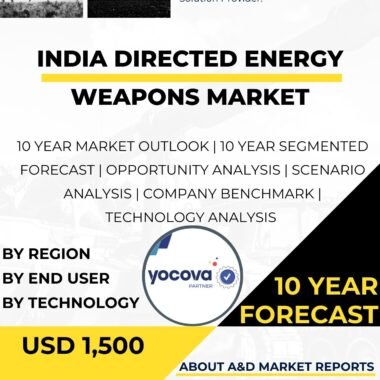Description
Malaysia Directed Energy Weapons market has gained momentum in recent years as the country expands its focus on advanced and emerging defense technologies. As a strategically located nation in Southeast Asia, Malaysia recognizes the growing importance of high-precision, fast-response systems to strengthen military readiness and safeguard national security. Directed Energy Weapons, which use concentrated energy to disable or destroy targets, have become increasingly attractive for their speed, accuracy, and operational flexibility.
Malaysia Directed Energy Weapons Market: Key Drivers
Malaysia’s push to modernize its armed forces is a major factor driving DEW adoption. The government aims to build a technologically sophisticated military capable of responding effectively to conventional and asymmetric threats. DEWs offer a valuable complement to traditional kinetic weapons, providing rapid engagement capabilities and reduced logistical burdens.
The precision of DEWs allows Malaysian forces to engage specific targets with minimal collateral damage. This advantage is especially important in urban or densely populated environments where conventional weapons may pose higher risks. DEWs also offer an effective response to low-cost threats such as small drones, rockets, and other airborne systems that can be difficult and expensive to intercept using standard missile defenses.
Malaysia Directed Energy Weapons Market: International Collaboration
Malaysia has placed strong emphasis on international partnerships to access advanced DEW technologies. Collaborations with major global defense companies have provided access to modern systems, technical expertise, and operational best practices. These partnerships also promote technology transfer, helping Malaysia build a more self-sufficient defense ecosystem capable of supporting long-term DEW development.
Malaysia Directed Energy Weapons Market: Domestic R&D Initiatives
Alongside international cooperation, Malaysia continues to invest in local research and development programs aimed at fostering indigenous DEW capabilities. Encouraging innovation within domestic institutions supports Malaysia’s broader goal of achieving greater defense self-reliance and strengthening the national defense industrial base. Local R&D efforts also stimulate knowledge growth, high-tech employment, and technological competitiveness.
Malaysia Directed Energy Weapons Market: Challenges
Despite promising progress, several challenges remain. The development and acquisition of DEW systems require substantial financial commitments, as these technologies involve complex research, testing, and integration processes. Budget limitations may influence procurement priorities and the pace at which Malaysia can adopt or develop DEW platforms.
Legal and ethical considerations also shape the deployment of Directed Energy Weapons. Their use must comply with international humanitarian law, particularly principles governing civilian protection and proportionality. Additionally, environmental and health concerns necessitate strict safety protocols to ensure DEW operations do not endanger military personnel, civilians, or surrounding ecosystems.
Future Outlook
The future of the DEW market in Malaysia appears promising as the government continues to prioritize defense modernization and advanced technology adoption. As DEWs mature and demonstrate greater reliability across different mission profiles, they are likely to play an increasingly significant role in Malaysia’s military planning and operational strategies.
Regional security developments may further accelerate demand for DEWs, especially as Malaysia seeks to maintain stability, strengthen deterrence, and enhance its strategic influence in Southeast Asia. The continued evolution of emerging threats—particularly UAVs and precision-guided munitions—will further emphasize the importance of adopting energy-based defensive solutions.
Conclusion
In conclusion, the Directed Energy Weapons market in Malaysia is progressing steadily, driven by modernization goals, international cooperation, and active domestic R&D efforts. DEWs offer Malaysia enhanced precision, rapid response capability, and cost-efficient countermeasures against a growing range of security challenges. To fully capitalize on these benefits, Malaysia must continue addressing challenges related to funding, legal frameworks, operational safety, and long-term technological development. With sustained investment and strategic planning, DEWs are poised to become an integral part of Malaysia’s defense landscape in the years ahead.




